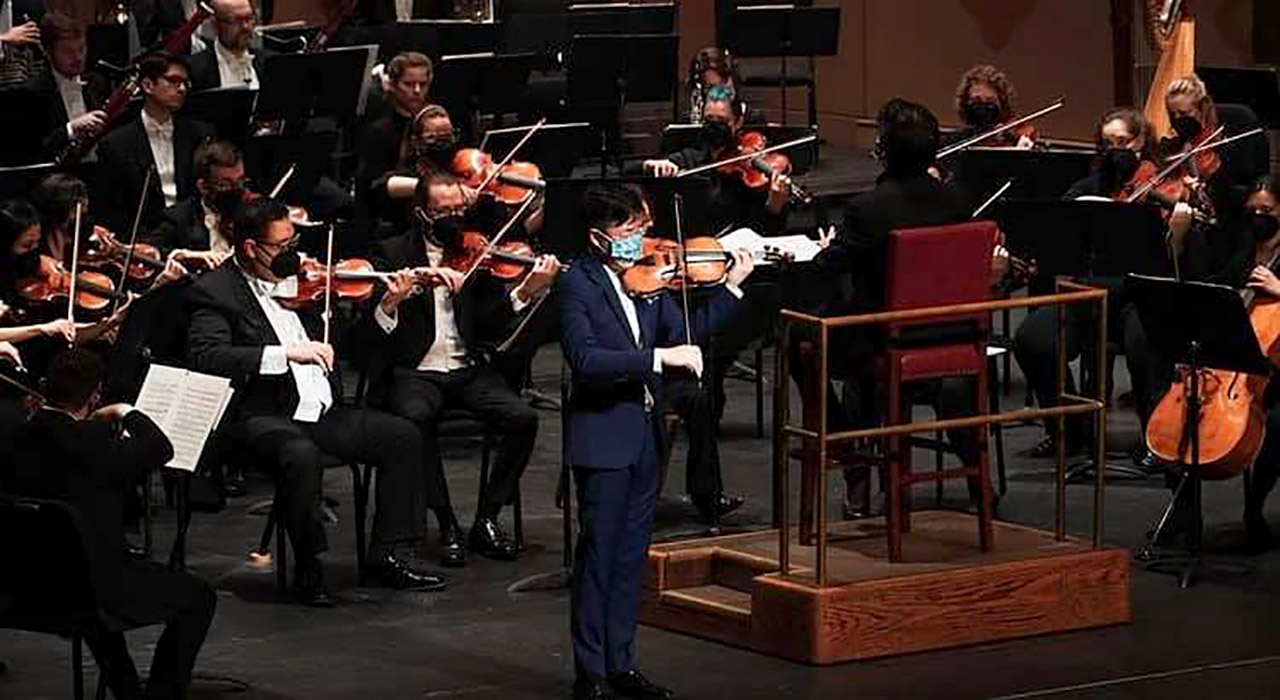If there was a word that combined “exhilaration” with “exuberance,” we would surely be using it today to describe the October installments of the Knoxville Symphony Orchestra Masterworks concerts this past Thursday and Friday evenings at the Tennessee Theatre. Even Maestro Aram Demirjian described the concluding work of three, Berlioz’ Symphonie Fantastique, as “epic”. In many ways, though, the entire evening, including the Max Bruch Violin Concerto No. 1 featuring violinist Paul Huang, was a musical feast of epic proportions that was probably as creatively exhilarating for the audience as it obviously was for Demirjian and the orchestra.
Following the recent idea of opening the Masterworks concerts with a contemporary work, often by a living female composer, Demirjian chose Sin Fronteras (Without Borders) by Brazilian-American, Chicago-based composer, Clarice Assad. Receiving a commission for the work in 2017 from the Chicago Sinfonietta, the composer has stated that the work is “…daring to erase imaginary lines that disconnect us geographically, culturally, and morally…” Such declarations aside, Sin Fronteras opens with a delicious darkness, but eventually dances its way through the Americas with complex, syncopated rhythms alternating with outbursts of addictive tunes. One might say it as if 70s TV theme music collided head-on with a runaway wagon of sophisticated jazz harmonies. Although loaded with intriguing woodwind moments and lusciously descriptive string work, one was drawn to the vigorous mallet-ed percussion textures, in this case, a showcase for the KSO percussionists.
One of only a handful of works by Max Bruch that sees many performances these days, the Violin Concerto No. 1 still occupies a respected spot in the violin concerto repertoire alongside such heavyweights as the Brahms, Tchaikovsky, and Sibelius concertos. While those latter works are certainly known for their emotional power and technical requirements, the Bruch has at its heart a subtle richness and melodic romance that is responsible for its enduring popularity.
Tapping that subtle richness was violinist Paul Huang, who last intrigued Knoxville audiences in 2017 with the Beethoven Violin Concerto. Huang played the Bruch with stunning precision and control of intricate bow strokes, but what marked the performance was his amazing range of dynamic contrasts within passages, all intelligently and articulately positioned. This was romantic musical sculpting at a most impressive degree, sculpting that was also being mirrored with solidity by Demirjian and the orchestra.
That subtle richness in the opening movement evolved into a lovely poignance in the Adagio, yet never losing warmth, clarity, or direction. The Finale movement was gloriously bold and assertive, and brought the audience to its feet for an extended ovation for this amazing and gifted violinist.
Fully wowed by Huang and the orchestra’s performance in the Bruch, intermission found us wondering if the second half of the evening, Berlioz’ Symphonie Fantastique, could possibly equal the energy and exhilaration. Not to worry—the excitement had just begun. Written to hopefully woo Irish actress Harriet Smithson, Berlioz poured his heart into the piece, giving it explosions of instrumental color from every section of the orchestra: thunder and lightning from the percussion, ominous utterings and heat from the brass, poignance from the strings and woodwinds.
Demirjian skillfully stirred the cauldron, keeping the work’s central theme for Smithson always lingering, either prominently or as vestiges of the idea, contrasted by moments of anguish and anger. The second movement’s waltz was a welcome sidestep from the opening. The third movement, “Scene in the Country,” featured the pastoral poignance of the English horn, played with an absolutely gorgeous warmth by Ayca Yayman, conversing with the offstage oboe, played beautifully by Principal Oboe Claire Chenette. Distant thunder from the multiple timpani set up the next movement “March to the Execution,” spelled out by the brass.
In the fifth movement, “Dream of a Witches’ Sabbath,” the theme is twisted into mockery by the clarinet, played here with a deliciously otherworldly effect by Principal Clarinet Gary Sperl. The low brass fulfilled their destiny with the anticipated penetration of the “Dies Irae” theme. The witches’ frenzy accelerated wildly until that final chord filled every nook and cranny of the Tennessee Theatre—an irresistible plea that almost impossibly turns doom into optimism. And that’s about as good as it gets.









Brilliant review of a brilliant evening. Thank you, Alan!